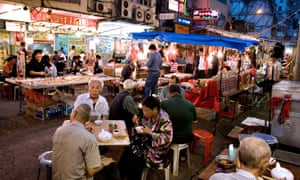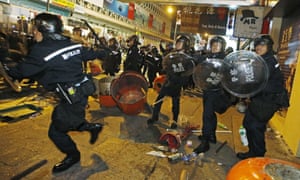Is Hong Kong really rioting over fishball stands?
Attempts to forcibly remove street food stands caused riots in Hong Kong on Monday. But there’s more to the #fishballrevolution than just snacks
The “fishball revolution” sounds like a joke, but when you look at the footage coming out of Hong Kong you realise it is anything but. Bloodied protesters, an injured policeman on the ground being attacked, warning shots fired in the air, 50 people arrested, almost 100 injured. Hong Kong specialises in wackily named quasi-uprisings – remember the Umbrella Movement of 2014? – but behind those curious names is an anger and alienation that pits the pro-Beijing government against a population, especially the young, who want western-style freedoms.
The fishball protests exploded on the streets of Mong Kok, the shopping heart of the Kowloon peninsula, at the start of Chinese New Year. The police had planned to close down the district’s unlicensed food stalls, which sell fishballs on skewers and other traditional Chinese snacks. The news leaked out, and protesters organised on social media ahead of the raids, and the standoff that resulted spilled over into violence as darkness closed in.
But why are young political activists willing to go to the wall for fishballs? “China has had really wonderful street food for at least 800 years, and it is part of the culture of Hong Kong,” says Chinese food expert Fuchsia Dunlop, author of Shark’s Fin and Sichuan Pepper: A Sweet-Sour Memoir of Eating in China. “It’s affordable and it’s fun. The street stalls are very much part of Hong Kong culture, but they’ve been disappearing as part of the process of redevelopment and urban renewal.”
For Hong Kong-born restaurateur Alan Yau, founder of Hakkasan and the Wagamama chain, the fishball has two meanings: “It is the quintessential Hong Kong street food and – culturally – it represents the Hong Kong working class like no other institutions can. Street food, and the fishball represent the values of entrepreneurship. Of capitalism. Of liberal democracy. Anthropologically, they mean more than a $5 skewer with curry satay sauce.”
The battle against gentrification has been added to the stew of protests against a government that, while officially autonomous, is reliant on Beijing. On Hong Kong island to the south, that battle has already been lost, with office blocks and swish apartments replacing the old way of life. But Mong Kok, with its narrow, congested streets and famous markets, has so far resisted the bulldozers.
“Street food is always a bit chaotic,” says Dunlop. “In mainland China, a lot of lively, unregulated street life has been swept away in the drive to modernise cities.” She points to the irony of China disrespecting its street food tradition at the same time as street food is becoming increasingly popular in the west. The stalls are an especially potent symbol in Hong Kong. “It has an incredibly foodie culture,” says Dunlop. “Everybody talks about food all the time, and it’s refreshingly unsnobby. Even very rich people will go everywhere – from very smart, expensive restaurants to little street stalls that do one thing particularly well.”
The Hong Kong government should tread carefully. After all, the American Revolution began with a riotous tea party.



沒有留言:
張貼留言